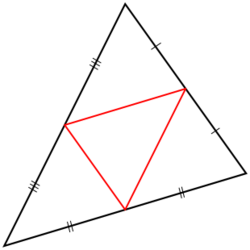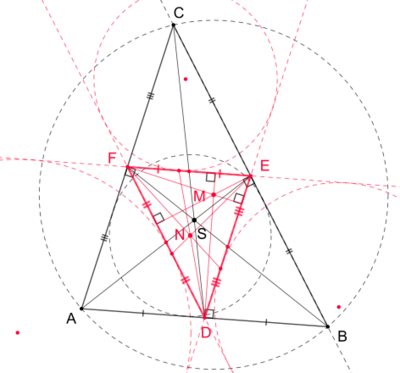Medial triangle
In Euclidean geometry, the medial triangle or midpoint triangle of a triangle △ABC is the triangle with vertices at the midpoints of the triangle's sides AB, AC, BC. It is the n = 3 case of the midpoint polygon of a polygon with n sides. The medial triangle is not the same thing as the median triangle, which is the triangle whose sides have the same lengths as the medians of △ABC.
Each side of the medial triangle is called a midsegment (or midline). In general, a midsegment of a triangle is a line segment which joins the midpoints of two sides of the triangle. It is parallel to the third side and has a length equal to half the length of the third side.
Properties
The medial triangle can also be viewed as the image of triangle △ABC transformed by a homothety centered at the centroid with ratio -1/2. Thus, the sides of the medial triangle are half and parallel to the corresponding sides of triangle ABC. Hence, the medial triangle is inversely similar and shares the same centroid and medians with triangle △ABC. It also follows from this that the perimeter of the medial triangle equals the semiperimeter of triangle △ABC, and that the area is one quarter of the area of triangle △ABC. Furthermore, the four triangles that the original triangle is subdivided into by the medial triangle are all mutually congruent by SSS, so their areas are equal and thus the area of each is 1/4 the area of the original triangle.[1]:p.177
The orthocenter of the medial triangle coincides with the circumcenter of triangle △ABC. This fact provides a tool for proving collinearity of the circumcenter, centroid and orthocenter. The medial triangle is the pedal triangle of the circumcenter. The nine-point circle circumscribes the medial triangle, and so the nine-point center is the circumcenter of the medial triangle.
The Nagel point of the medial triangle is the incenter of its reference triangle.[2]:p.161,Thm.337
A reference triangle's medial triangle is congruent to the triangle whose vertices are the midpoints between the reference triangle's orthocenter and its vertices.[2]:p.103,#206;p.108,#1
The incenter of a triangle lies in its medial triangle.[3]:p.233,Lemma 1
A point in the interior of a triangle is the center of an inellipse of the triangle if and only if the point lies in the interior of the medial triangle.[4]:p.139
The medial triangle is the only inscribed triangle for which none of the other three interior triangles has smaller area.[5]:p. 137
The reference triangle and its medial triangle are orthologic triangles.
Coordinates
Let [math]\displaystyle{ a = |BC|, b = |CA|, c = |AB| }[/math] be the sidelengths of triangle [math]\displaystyle{ \triangle ABC. }[/math] Trilinear coordinates for the vertices of the medial triangle [math]\displaystyle{ \triangle EFD }[/math] are given by
- [math]\displaystyle{ \begin{alignat}{3} E &={} \, 0 &&: \frac{1}{b} &&: \frac{1}{c}, \\[5mu] F &={} \frac{1}{a} &&: \,0 &&: \frac{1}{c}, \\[5mu] D &={} \frac{1}{a} &&: \frac{1}{b} &&: \, 0. \end{alignat} }[/math]
Anticomplementary triangle
If [math]\displaystyle{ \triangle EFD }[/math] is the medial triangle of [math]\displaystyle{ \triangle ABC, }[/math] then [math]\displaystyle{ \triangle ABC }[/math] is the anticomplementary triangle or antimedial triangle of [math]\displaystyle{ \triangle EFD. }[/math] The anticomplementary triangle of [math]\displaystyle{ \triangle ABC }[/math] is formed by three lines parallel to the sides of [math]\displaystyle{ \triangle ABC }[/math]: the parallel to [math]\displaystyle{ AB }[/math] through [math]\displaystyle{ C, }[/math] the parallel to [math]\displaystyle{ AC }[/math] through [math]\displaystyle{ B, }[/math] and the parallel to [math]\displaystyle{ BC }[/math] through [math]\displaystyle{ A. }[/math]
Trilinear coordinates for the vertices of the triangle [math]\displaystyle{ \triangle E'F'D' }[/math] anticomplementary to [math]\displaystyle{ \triangle ABC }[/math] are given by
- [math]\displaystyle{ \begin{alignat}{3} E' &= -\frac{1}{a} &&: \phantom{-}\frac{1}{b} &&: \phantom{-}\frac{1}{c}, \\[5mu] F' &= \phantom{-}\frac{1}{a} &&: -\frac{1}{b} &&: \phantom{-}\frac{1}{c}, \\[5mu] D' &= \phantom{-}\frac{1}{a} &&: \phantom{-}\frac{1}{b} &&: -\frac{1}{c}. \end{alignat} }[/math]
The name "anticomplementary triangle" corresponds to the fact that its vertices are the anticomplements of the vertices [math]\displaystyle{ A, B, C }[/math] of the reference triangle. The vertices of the medial triangle are the complements of [math]\displaystyle{ A, B, C. }[/math]
See also
- Middle hedgehog, an analogous concept for more general convex sets
References
- ↑ Posamentier, Alfred S., and Lehmann, Ingmar. The Secrets of Triangles, Prometheus Books, 2012.
- ↑ Jump up to: 2.0 2.1 Altshiller-Court, Nathan. College Geometry. Dover Publications, 2007.
- ↑ Franzsen, William N.. "The distance from the incenter to the Euler line", Forum Geometricorum 11 (2011): 231–236.
- ↑ Chakerian, G. D. "A Distorted View of Geometry." Ch. 7 in Mathematical Plums (R. Honsberger, editor). Washington, DC: Mathematical Association of America, 1979.
- ↑ Torrejon, Ricardo M. "On an Erdos inscribed triangle inequality", Forum Geometricorum 5, 2005, 137–141. http://forumgeom.fau.edu/FG2005volume5/FG200519index.html
External links
- Weisstein, Eric W.. "Medial triangle". http://mathworld.wolfram.com/MedialTriangle.html.
- Weisstein, Eric W.. "Anticomplementary Triangle". http://mathworld.wolfram.com/AnticomplementaryTriangle.html.
de:Mittelparallele#Mittelparallelen eines Dreiecks
 |



